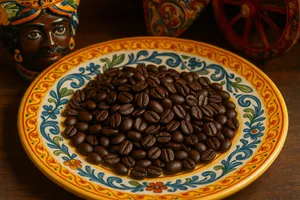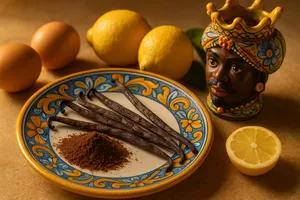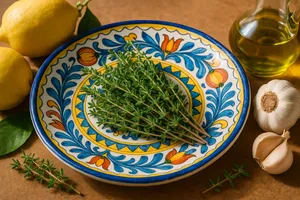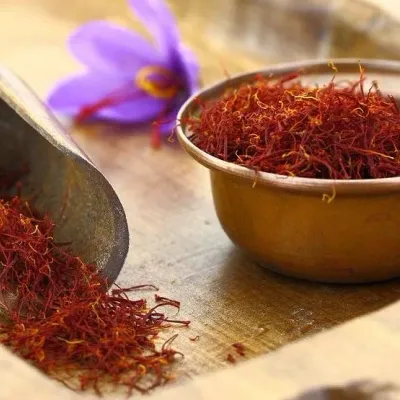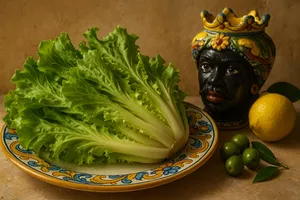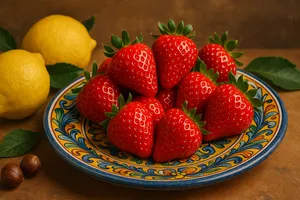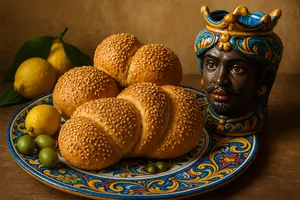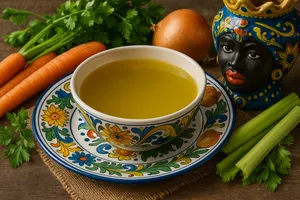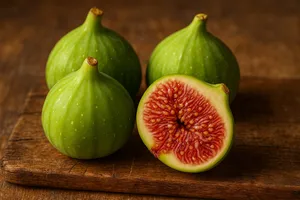Overview
Sesame, known in Sicilian as “giuggiulena” or “ciminu” (though the latter can be confused with anise), is a small oilseed harvested from the Sesamum indicum plant, native to India and Africa and cultivated for millennia for its edible seeds, exceptionally rich in oil, protein, and minerals. The seeds are tiny (2–3 mm), oval and flattened, with colours ranging from cream-white to brown, black, or red, depending on the variety. When toasted, they have a delicate, nutty flavour. In Sicilian cuisine, sesame has a long history tied to Arab rule, which introduced the plant to the island: it is a traditional ingredient in bread (the famous “mafalde” or sesame-covered loaves), biscuits (“biscotti regina” or “reginelle” coated in sesame), sweets (sesame nougat, “giuggiulena”), and savoury dishes where toasted seeds add crunch and flavour.
In Sicily, sesame has historically been cultivated in the hottest and driest areas (southern coastal zones and inland plains), where the Mediterranean climate is ideal for the crop. Harvesting seeds from the mature capsules was once painstaking and delicate work. Today, cultivation is reduced compared to the past but survives in some areas, and Sicilian sesame is still prized for its quality. Beyond culinary use, sesame is pressed to obtain a fine oil used in Eastern cooking and cosmetics. Sesame represents Arab influence in Sicilian cuisine, linking the island to Middle Eastern traditions. Its toasted, nutty character enriches both sweet and savoury preparations, offering concentrated nutritional richness in tiny seeds. In Sicilian folk culture, sesame evokes childhood sweets, fragrant freshly baked bread, and the ancient wisdom of simple but powerful ingredients.
Characteristics
Sesame seeds are very small (2–3 mm long), oval and flattened, with a smooth surface. Colour varies by variety: white (light cream), black (deep black), brown, or red. In Sicily, white and black sesame are the most common.
The flavour is delicate and slightly sweet, with nutty notes, especially when the seeds are toasted. Raw seeds have a more neutral taste. The aroma is pleasant and reminiscent of toasted nuts. The texture is crisp when chewed.
The seeds are extremely rich in oil (around 50% of their weight), making them caloric but an excellent source of healthy fats. They also contain protein, fibre, minerals (calcium, iron, magnesium, zinc, copper), and vitamins (B and E).
Varieties
White sesame
The most common variety, with pale cream-coloured seeds. They are usually hulled (without the outer coating). Their flavour is delicate, and they are used for bread, sweets, and decoration. These are the seeds typically seen on hamburger buns, breadsticks, and crackers.
Black sesame
Seeds with the black outer hull intact, unhulled. Their flavour is slightly more intense and earthy; they are richer in fibre and antioxidants. Used widely in Asian cuisine and increasingly in contemporary cooking for visual contrast. In Sicily they are less traditional but appreciated.
Toasted sesame
White or black seeds toasted in a pan or oven. Toasting enhances their nutty flavour and makes them more aromatic and crunchy. They are used as a finishing touch on dishes, salads, and vegetables.
Cultivation
Sesame is an annual plant that thrives in hot, dry climates. It reaches 50–100 cm in height, with elongated leaves and white-pink flowers. After flowering, elongated capsules form, containing the seeds.
The plant is drought-resistant but requires well-drained, fertile soil and full sun. Sowing takes place in spring, and harvesting occurs in late summer or autumn when the capsules mature and begin to split open (hence the expression “open sesame”, referring to the capsule revealing its seeds).
In Sicily, sesame cultivation was once widespread in the southern coastal areas and warm plains. Today it is less common due to competition from low-cost imports, but some producers continue growing high-quality Sicilian sesame.
Use in Sicilian cooking
Sicilian sesame bread
A traditional use: bread (mafalde, rolls, loaves) is sprinkled with sesame seeds before baking. The seeds adhere to the moist dough and toast in the oven, creating a crisp, golden, aromatic crust. Sicilian sesame bread is iconic.
Biscotti regina (reginelle)
A traditional Sicilian biscuit: oval soft shortcrust biscuits completely coated in sesame seeds. They have a crumbly texture and a delicate almond-and-sesame flavour. They are festive biscuits, made for special occasions.
Giuggiulena (sesame torrone)
An ancient Sicilian sweet: toasted sesame seeds mixed with honey or caramelised sugar, poured into moulds, then cut into diamonds or rectangles. It has a crunchy texture and an intense sesame-and-honey flavour. Similar to almond brittle but made with sesame.
Trapani couscous
In couscous alla trapanese, toasted sesame seeds may be added for crunch and flavour. Not an essential traditional ingredient, but a welcome enhancement.
Seasoning for vegetables
Toasted sesame seeds are sprinkled over cooked vegetables, salads, and sides to add crunch, flavour, and nutritional value. This use is more common in contemporary cooking than in traditional dishes.
Sweets and assorted biscuits
Sesame enriches numerous Sicilian cakes, biscuits, and pastries. It is added to doughs or used as outer decoration.
Tahini (sesame paste)
Though not traditionally Sicilian, tahini (a paste of ground sesame seeds) is increasingly used. It is a Middle Eastern ingredient (hummus, halva) now entering contemporary Italian cooking.
Toasting sesame
Toasting sesame seeds enhances their flavour and aroma:
1. Place the seeds in a dry non-stick pan (without oil).
2. Heat over medium heat, stirring continuously with a wooden spoon.
3. After 3–5 minutes, the seeds will become fragrant and lightly golden.
4. Once golden (not burnt, or they become bitter), remove immediately from the pan and transfer to a plate to stop cooking.
5. Allow to cool completely.
Toasted seeds keep in a sealed jar for several weeks, though their flavour is best when freshly toasted.
Sesame oil
Sesame seeds are pressed to obtain a rich, refined oil. Two main types exist:
Cold-pressed sesame oil (light): Pale yellow in colour with a delicate flavour. Used for raw dressings and gentle cooking.
Toasted sesame oil (dark): Obtained from seeds toasted before pressing, dark brown with an intense toasted-nut flavour. Used as a final aromatic seasoning in Asian cooking (a few drops suffice). It is very concentrated.
Sesame oil is rich in beneficial unsaturated fats and antioxidants (sesamin, sesamolin). It is stable and keeps well. Not traditional in Sicily but increasingly known.
Storage
Sesame seeds should be stored in an airtight container (glass jar) in a cool, dry, dark place for 6–12 months. Their high oil content makes them prone to rancidity if exposed to heat, light, or humidity.
Toasted seeds have a shorter shelf life (2–3 months) because toasting accelerates oxidation. It is best to toast them just before use.
Refrigeration extends their shelf life (1–2 years). This is ideal for organic seeds, expensive varieties, or large quantities.
Tips for buying
Choose organic sesame seeds when possible to avoid pesticide residues. Ensure they are dry, free-flowing, and without clumps (a sign of moisture). Their aroma should be pleasant and nutty, never rancid.
Choose small packages if you use them infrequently, to avoid rancidity. Vacuum-sealed or protected-atmosphere packaging preserves freshness better.
Sicilian sesame, when available, is of excellent quality and supports local producers. It is more expensive than imported sesame but has superior flavour.
Nutritional properties
Sesame seeds are highly nutritious: 100 g provide about 570–600 calories (very caloric due to the high oil content). They contain 17–20 g of good-quality protein, 50–55 g of fat (mainly beneficial unsaturated fats: omega-6 and omega-9), 10–12 g of carbohydrates, and 10–12 g of fibre.
They are exceptionally rich in calcium (around 800–1000 mg per 100 g, among the richest plant sources), iron, magnesium, phosphorus, zinc, copper, and vitamins B1, B6, and E. They contain lignans (sesamin, sesamolin) with antioxidant, anti-inflammatory, and lipid-lowering properties.
Sesame seeds support bone health (calcium, magnesium), heart health (unsaturated fats), and glycaemic control (fibre, protein). They should be consumed in moderation due to their high caloric content: 1–2 tablespoons per day is a reasonable amount.
Sesame allergy is relatively common and can be severe. In some countries it is a mandatory allergen for labelling.
Sesame in Sicilian tradition
Sesame arrived in Sicily with the Arabs (9th–11th centuries), who introduced numerous plants and agricultural techniques. The Sicilian climate proved ideal for cultivation.
The Sicilian word “giuggiulena” derives from the Arabic “juljulān”, confirming its origins. Sesame quickly became part of the island’s cuisine, especially in pastry-making and breadmaking.
Sweets made with sesame were (and are) prepared for religious feasts, weddings, and celebrations. Biscotti regina were considered prestigious sweets, offered to important guests.
Sicily once had significant sesame cultivation. Farmers grew the plants, harvested the capsules, and extracted the seeds. It was patient work but rewarding.
Curiosities
The expression “Open sesame” from the tale of Ali Baba in the “One Thousand and One Nights” refers to the sesame capsule that naturally splits open when ripe, revealing its precious seeds. It is a perfect metaphor for hidden riches revealed.
Sesame seeds are among the oldest oilseeds cultivated by humankind. Evidence of their cultivation in Mesopotamia dates back over 4000 years. They were considered valuable and used even as a form of currency.
In Ayurvedic and Chinese traditional medicine, sesame seeds (especially black ones) are regarded as tonics, invigorating, and beneficial for longevity. They are used in medicinal preparations.
Sesame is mentioned in ancient Egyptian, Greek, and Roman texts. It was valued for its durable oil, which resisted rancidity and was prized for lamps, cosmetics, and medicine.
An old Sicilian saying goes: “'A giuggiulena è picciridda ma forti” (“Sesame is small but strong”), referring to the concentrated nutritional power of tiny seeds. It highlights that size is no measure of worth.
In some Sicilian folk traditions, sesame seeds were considered good-luck symbols, representing prosperity. Sweets containing sesame were offered to newlyweds to wish them fertility and abundance.
Black sesame, richer in antioxidants thanks to anthocyanins in the hull, is considered more “medicinal” in Eastern medicine. In Sicily it is less traditional but gaining popularity.
The sesame plant is beautiful when in bloom: delicate white or pink flowers resembling small bells. It is ornamental as well as useful, an example of a plant that combines beauty with utility.



